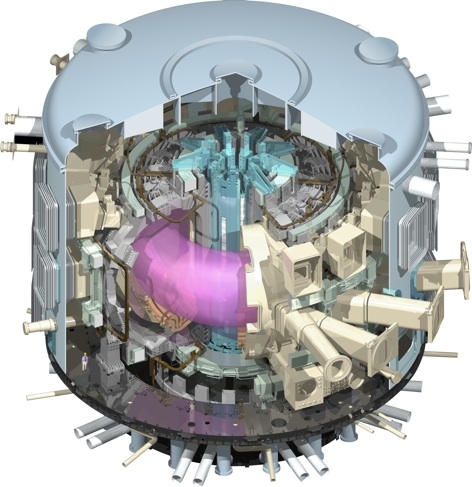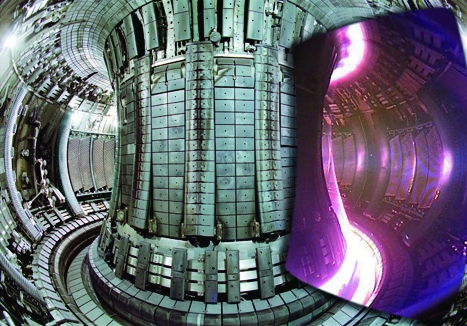Stuart Nathan
Features Editor
The UK should ensure its future within the nuclear fusion community, says Stuart Nathan

Our poll last week showed that the large proportion of respondents were concerned that the UK's withdrawal from the Euratom treaty would derail progress in nuclear fusion. This is an aspect of the issue which has not been mentioned to a great extent, but it is one that should be of great concern to everyone.
The cliche about fusion, of course, is that it's 30 years away, always has been and always will be. We regularly receive comments calling it a "pipe dream" and a black hole for investment. However, proponents argue that progress made by plasma physics experiments around the world – and particularly in the UK, which hosts the world's largest current experiment in fusion using the magnetic confinement method, the Joint European Torus (JET) at Culham in Oxfordshire – mean that that thirty-year horizon may actually now be a reality, and the countdown is on. Building work on ITER, which uses the same technology as JET but is twice the size, is well underway at Cadarache near Marseilles, and its scientists are confident that the device will demonstrate the practicality of industrial-scale fusion that could be used to generate power. Having visited the site and covered the issue for some years, I share their optimism.

JET is in the UK because of our membership of Euratom, and although its future is guaranteed until 2018, if we leave the treaty it is at serious risk. This would be a major setback for ITER, because although JET is not the only facility in the world to use the magnetic confinement fusion method, it is the largest and the only one which is able to use tritium (the heavy isotope of hydrogen which is radioactive) in its experiments, and therefore the only one capable of actually generating nuclear fusion. It is the best device for testing techniques to control the hot plasma that is the fuel of fusion, and to examine its behaviour under fusion conditions. It is also the main place for testing the operation of the large magnets that are an integral part of the fusion technique; although ITER's magnets will be superconducting and JET's are not, they have the same geometry and no other device in the world shares this.
The UK also participates in ITER through its membership of Euratom, although this is not quite such a crisis because there are several states in the ITER consortium which are not Euratom members, such as the US. This does mean, however, that a new relationship will have to be negotiated: yet another task for hard pressed civil servants and one that we would have to imagine will not be high on the agenda, because it hasn't been mentioned by any of the politicians involved in Brexit.
Emotions are running high over the UK’s exit from Euratom. One materials scientist told me last week that it was the moment he realised that the politicians didn't have a clue, and he described it as pure vandalism. The reasons we are leaving are not entirely clear, but seem to be connected to the legal aspects of the treaty being within the jurisdiction of the European Court of Justice, an institution which is unpopular within the Conservative party and its supporters in the media, and whose jettisoning is seen as a key part of the Brexit process by the powers that be. The issue is, like so many parts of Brexit, arguable but in the mind of Theresa May, at least, the ECJ is one of those things that we cannot be part of if we leave the EU.
But for us, abandoning fusion would be nothing short of a betrayal. Not only that, it runs counter to all the principles Mrs May expounded in her speech setting out what she hoped to achieve by Brexit. Fusion can only be achieved by collaboration with other countries; it is essentially outward looking and internationalist. It is at the highest level of science and engineering, which Mrs May promised would not be damaged by Brexit. It supports jobs and industries in the UK, in key fields such as advanced manufacturing and robotics. And it could be a valuable tool in reducing the carbon emissions from energy generation. There can be no doubt that all of these are goals which the government must be keen to be seen supporting.
Not only that, but as I have argued before fusion is perhaps the ultimate expression of optimism and belief in technological solutions to solve our problems, a philosophy which has been central to energy policy for decades. If, as engineers, we do not believe in this then we might as well all pack up and find another vocation. Magnetic fusion, admittedly, is not the only game in town when it comes to fusion research (as the researchers at the US National Ignition Facility, NIF, in California will argue) but inertial confinement, the technique used at NIF, is not as far advanced as magnetic confinement and, because of its origins in weapons research, tends to be less attractive for investment for several governments. Other techniques, such as those using elements other than hydrogen as fuel, are decades behind despite having promise; a compact fusion technology being developed by Lockheed Martin since last year is a variant of magnetic confinement and in its very early stages. ITER is our best bet for fusion in the near(ish) future.
Fusion is not a pipe dream. It works; the method used to produce it at an industrial scale has been demonstrated as JET and will be again in the coming year. It is hardly an exaggeration to say that the UK's participation in ITER will be key to its success, as we are leading the vital magnet section of the project. It is in everybody's interest that we do not abandon fusion. Its promise is such that it could be key to the future of our civilisation.





Red Bull makes hydrogen fuel cell play with AVL
Surely EVs are the best solution for motor sports and for weight / performance dispense with the battery altogether by introducing paired conductors...